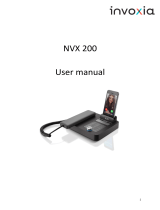
Product Manual — Doc. 8918A DM-NVX-E760 and DM-NVX-E760C • 11
In the Stream section, do the following:
1. Under Services, enable Preview Output if it is disabled by setting the Preview Output toggle
switch in the On (right) position (default setting). If video is present, video is displayed in the
Preview window above Services. (Double-clicking the Preview window displays the video
window full screen.)
2. Enter a base file name (prefix) to the file name of the images to be generated. The default
base file name is preview.
The Generated Preview Images table lists the image previews. Type indicates the height of
the image in pixels. File Name indicates the file name of the image in the following format:
<base file name>_<vertical resolution>px.<extension>
l <base file name> is the prefix assigned to the image preview followed by an underscore.
If the default base file name of preview is changed, clicking the table updates the base
name in the table.
l <vertical resolution> is the height of the image in pixels (px).
l <extension> is the file format of the image. The default file extension is .jpeg.
For example, using the default base file name, which is preview, and a JPEG image with a
vertical resolution of 240 pixels, the file name of the image preview is preview_240px.jpeg.
Local Preview Path indicates the /preview location to which image preview files are saved
to the web server of the DM NVX device. An image preview file can be accessed from a web
browser on a remote device by entering the following URL:
https://<username>:<password>@<ip address>/preview/<filename>
l <username> is the user name used to access the DM NVX web server.
l <password> is the password used to access the DM NVX web server.
l <ip address> is the IP address of the DM NVX device.
l <filename> is the file name of the image preview file.
For example:
https://admin:admin@172.30.160.90/preview/preview_540px.jpeg
l admin is the user name used to access the DM NVX web server.
l admin is the password used to access the DM NVX web server.
l 172.30.160.90 is the IP address of the DM NVX device.
l preview_540px.jpeg is the file name of the image preview file.
Using SIMPL Windows
Enable or disable image preview functionality in Slot-1003: DM Preview Image. Trigger the
<Enable> digital input join to enable image preview functionality. To disable image preview
functionality, trigger the <Disable> digital input join. For additional information, refer to the SIMPL
Windows help file.























